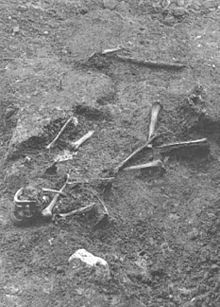Rappendam moor
The Rappendam Bog is an archaeological site in a valley near Frederikssund on the Danish island of Zealand , 1 km east of the medieval Jørlunde Church . It was discovered by peat workers and examined by the National Museum in 1941 and 1942. The excavator was Georg Kunwald .
The finds
Seven find complexes lay on an area of 8 × 62 m in the same horizon. It is believed that these depots were originally deposited on the bank of a silting lake. The skeleton of a 30-35-year-old woman as well as bicycles and wheel fragments were found. Some of them were only symbolic and could not be used at all.
The woman was lying on her back, her left arm at her side and the right one across her chest. According to the position of the foot bones, the knees were probably originally drawn. The position of the skull suggests that the woman's throat may have been cut, as has been observed in other bog bodies . The dead woman was carefully put down.
Only the skull and the limbs of the horse have been deposited. This type of dumping has already been observed several times and is attributed to a ritual laying down of the horse's skin after all soft tissues have been removed. Furthermore, the bones of a cow were recovered.
63 car parts were also found, 40 of which were disc wheels or their parts, 18 wheel hubs or their parts, three axles or their parts and three fragments of wagons . It is by far the largest number of wagon parts in the same find horizon in north-western Europe. The wheels are either one or three piece disc wheels. Their diameter is 45–80 cm and they are 5–10 cm thick. The wood comes from beech, oak, alder or linden (not roadworthy). The wheels originally belonged to wagons pulled by oxen. There are seldom wheels that could have formed a wheel pair. The hubs were loose.
Attempts were made to reconstruct the corresponding wagons from the finds; in research, these are called Rappendam-type wagons or R-wagons , because their parts are most frequently found here. However, no wagons can be put together from the parts, because it was not a question of wagon dumping, but rather a victim find with wagon parts as an essential group. The reconstruction contains an axle with two wheels on which a forked rod lies. The fork ends are attached to the axle. The bar is used for pulling by a team of oxen. In the middle between the fork ends there is a forked piece of wood on the axis, which is rotatably fixed. Its ends point to the rear and lie on the rear axle. The car body was on the second fork.
In addition, three plowshares and some indeterminable wooden implements were found. Pollen analyzes showed that the finds belong to the Iron Age. 14 C-analyzes showed that the plowshares can be dated to the Bronze Age and Pre-Roman Iron Age. Three cartwheels were with the 14 C method to the period between the 1st and 2nd century dated. A further 161 pieces of wood were also recovered, many of which were processed in different ways. The function of some finds could not be determined, they are interpreted as symbolic representations.
The interpretation
The interpretation proposed was that on the Rappendamer lake shore over a long period mainly wagon parts, especially bicycles, agricultural implements and pets, as well as a woman were sacrificed. An annually recurring sacrifice is assumed, whereby the horse and the woman are included in a sacrifice that may have been made in a crisis situation.
The wheels could also have been used as symbols of the sun . A forked piece of wood has a notch in the middle of the fork. The piece is similar to other Iron Age pieces of wood, which, because they are human-like, are interpreted as female idols. On the other hand, the processing shows that it must have been the lower part of a long car. This puzzling double function could point to a goddess to whom the long chariot was dedicated and who was worshiped at this place.
literature
- Jan Bemmann, Güde Hahne: Ancient Iron Age sanctuaries in northern Europe according to the archaeological sources . In: Germanic Religious History. Sources and source problems (= supplementary volumes to the Reallexikon der Germanischen Altertumskunde ). No. 5 .. Berlin 1992, p. 29-69 .
- Georg Kunwald: Rappendam. In: Reallexikon der Germanischen Altertumskunde (RGA). 2nd Edition. Volume 24, Walter de Gruyter, Berlin / New York 2003, ISBN 3-11-017575-4 , pp. 132-136.
- Georg Kunwald: The moor find in Rappendam, Zealand, Denmark . In: Prehistoric sanctuaries and places of sacrifice in Central and Northern Europe . 1970, p. 100-118 .
Coordinates: 55 ° 49 ′ 51.7 " N , 12 ° 11 ′ 5.3" E

